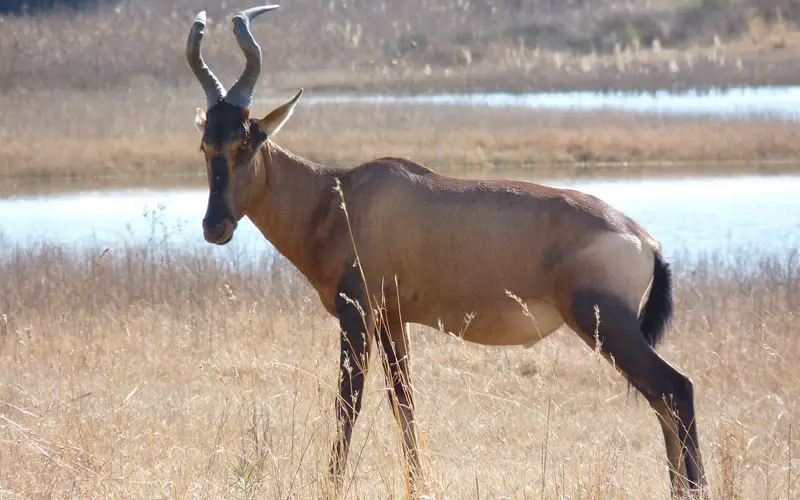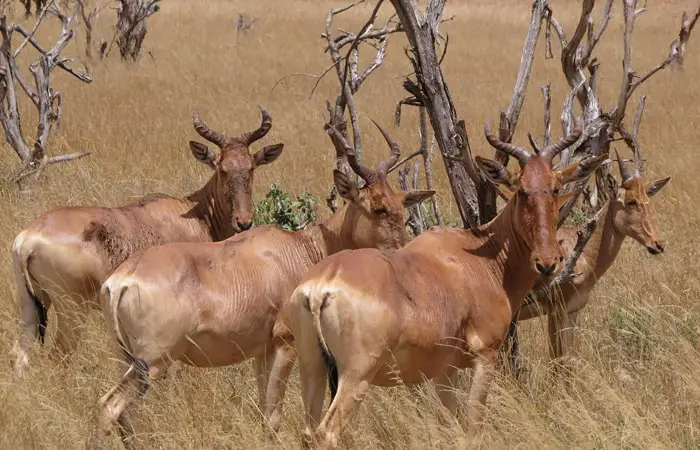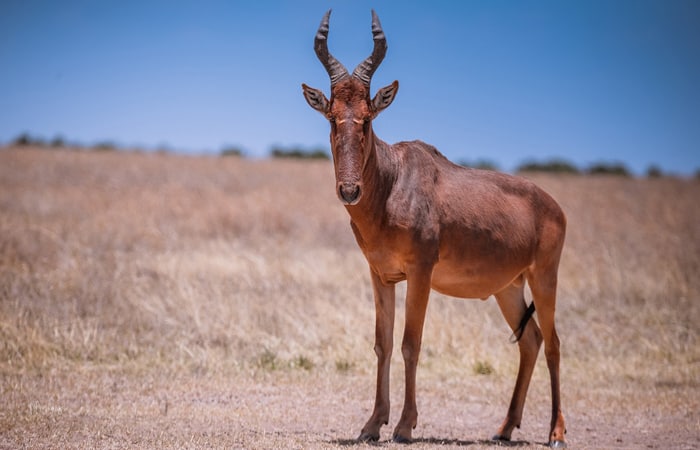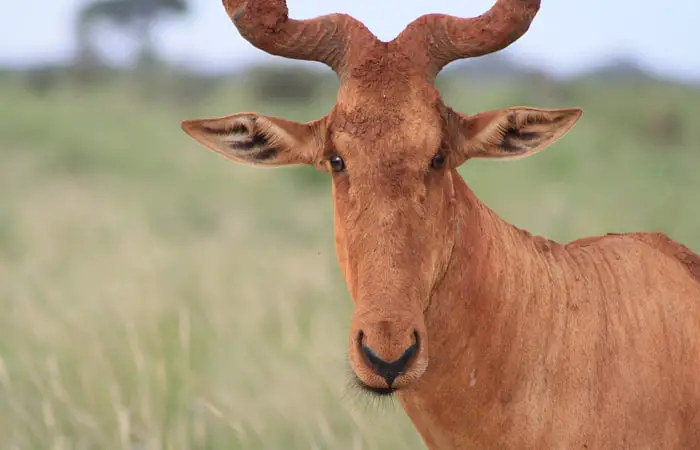Table of Contents
*This post may contain affiliate links. As an Amazon Associate we earn from qualifying purchases.
If you are interested in African wildlife, you likely already know about the wild and wonderful hartebeest. Did you know, though, that they come in a variety of sizes and colors? Or that they stay close by their mothers long after they are adults?
There are many interesting things to learn about this wonderful creature.
What Is a Hartebeest?

A hartebeest is a large antelope that belongs to the bovid species. There are many types of hartebeests scattered throughout Africa, where they are common in the grasslands, savannas, and sparsely wooded areas.
They are an endangered species because they are having a hard time finding food and have been hunted to near extinction. However, with adequate conservation efforts, they can bounce back.
There are many reasons to work together to save the hartebeest. In the section that follows, we will talk more about what makes them special and the part they play in the animal kingdom.
14 Things to Know About the Hartebeest
Hartebeests are fascinating creatures and there is a lot of neat information to learn about them.
Like all wildlife, they have very carefully orchestrated patterns in which they raise their babies, protect themselves from predators, and survive. Below, we will discuss 14 important hartebeest facts that anyone interested in the species should know.

1. Hartebeests Are Herbivorous Animals
Herbivores are animals that eat vegetation exclusively. While carnivores prefer meat and omnivores can eat either meat or plants and often prefer to eat both, an herbivore will only eat plants.
Herbivores’ teeth are flatter, used for mashing plants rather than tearing away meat or opening shells. The hartebeest’s diet is based almost entirely on grass, so it is frequently moving and finding new places to graze.
2. The Hartebeest Can Get Pretty Big
These animals can reach about 5 feet in length, meaning they are about as long as most middle-school students. They can also weigh up to 350 pounds!
They can also be pretty small, though. Some adult hartebeests are only 3 feet long and around 165 pounds. The size simply depends on genetics, for the most part. Similar to people, they come in various shapes and sizes.
Gender does play a role, too, however. Male hartebeests are larger than female hartebeests, as is the case with most deer-like animals.
3. Hartebeests Grow Up Fast
It only takes a baby hartebeest about a year to reach maturity. While they will still be smaller than their counterparts, they can at this time do all the same thing that adult hartebeests do.
This is when male hartebeests will begin to wander on their own and establish a territory. It is also when female hartebeests might begin to have their own babies.
By the age of four years, all hartebeests will have reached their full adult size and weight.
4. Hartebeests Have Several Natural Enemies
Throughout the hartebeest’s life, its natural enemies change a bit, but one thing remains the same – they have to always be on the lookout for dangerous predators.
When hartebeests are young, they have to watch out for cheetahs and jackals. These animals prefer the taste of the younger animals. As they get older, though, they don’t find much relief from their worry. Lions, leopards, and hyenas tend to target the adults of the species.
5. There Are Various Colorations of the Hartebeest
The hartebeest can have any of several different fur colorations. The most common coloration for the hartebeest is a tan or golden brown. You can also find them in a reddish brown color and, most rarely, dark brown or almost black.
Their fur is short over their body and heads. However, they sometimes have longer hair on their tails. This is found most commonly on darker-colored hartebeests.
6. Hartebeests Love Their Mothers
Even though most hartebeests are ready to begin their own lives at around one year of age, they will stay close to their mothers until they are around three. Even male hartebeests will establish territory close to their mother, often with “bachelor herds” which are made up of similarly aged male calves that are first setting out from a female herd.
Young females will allow their mothers to teach them about raising babies and finding food, sometimes even letting their mothers nurse their “grand-calves.”
7. Hartebeest Mothers Love Their Babies
A mother hartebeest is typically pregnant for around eight months. Usually, they only have one calf at a time. However, twins do occur. Usually, when a mother has one set of twins, she will have many more throughout her life.
When the mother is ready to have her baby, she will leave the herd and give birth in a quiet, covered area. She will stay there alone with her baby for the first two weeks until it grows strong enough to run should a predator attack. This is when they will rejoin the other females in the herd.
8. Hartebeests Are Diurnal
You will find two different classifications of animals – nocturnal and diurnal.
Nocturnal means the animal is most active at night. They do their hunting, gathering, and grazing during this time.
Hartebeests, however, are diurnal. They naturally are on the move during the daytime. At night, they find a safe place to huddle and rest as a herd. Most deer-like species are diurnal because they see better in daylight and are able to avoid predators during the day. However, you will occasionally find them on the move at night, particularly during migratory seasons.
9. Male Hartebeests Can Be Aggressive
Male hartebeests don’t like to compete with one another, so they often will section off territories, particularly during mating season. They will use their own dung to mark off their territory so that another knows when they are intruding.
If a male hartebeest should intrude on another male’s space, though, a fight becomes likely. Sometimes, they are even known to fight to the death.
10. Hartebeests Are Very Fast!
You would never guess it from looking at their lanky and clumsy build, but hartebeests are some of the fastest animals in the world. This comes in handy when the hartebeest is trying to escape from a predator.
When running, the hartebeest can reach speeds of up to 43 miles per hour. This is similar to a car speed on a busy city street.
11. Both Male and Female Hartebeests Have Horns
Depending on size and gender, the horns can range anywhere from 18 to 28 inches when fully formed. While it is a common misconception that only males have horns, the female of many deer species also boast them.
For the hartebeest, their horns are curved and set closely together at the base. Toward the bottom of the horns, there are dark rings that lighten and fade out completely toward the top.
12. Baby Hartebeests Are Called “Calves”
We usually associate the term “calves” with the offspring of cows, but the name applies to baby hartebeests, too. Calves are born at any time of the year, but most often, they are born in the rainy season. Hartebeests like to plan their calving to this period because it is when food is more readily available.
Nobody knows for sure how the hartebeests manage to time their reproduction. It’s a mystery of the animal kingdom.
13. Hartebeests Look Out for One Another
Female hartebeests form herds of 5-15 animals. They stick together and help one another look after the babies after they are born.
Male hartebeests tend to wander off on their own most of the time, but never too far away from their families. When the climate gets dry during periods of drought, the males will rejoin the herd and help the females find food and water.
14. Hartebeests Can Live for a Pretty Long Time
Hartebeests have been known to live up to 20 years. Unlike some other animals, there doesn’t seem to be a significant difference in lifespan in regard to animals that live in the wild or animals that live in captivity. They have been known to live just as long in either place.
If a female hartebeest lives to be 20, she will have delivered anywhere between 19 and 30 babies in her lifetime.
The Hartebeest Is an Amazing Animal

The hartebeest is a family-oriented, gentle, and kind member of the bovid family that inhabits much of Africa. While they used to be a common sight in the African wild, they have been hunted and starved to near extinction in recent years.
With proper conservation efforts, we can save the hartebeest together and allow their gentle spirit to continue to inhabit the savanna.

